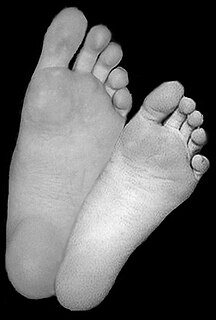
Medical physics is, in general, the application of physics concepts, theories, and methods to medicine or healthcare. Medical physics departments may be found in hospitals or universities.
Reliability in statistics and psychometrics is the overall consistency of a measure. A measure is said to have a high reliability if it produces similar results under consistent conditions. "It is the characteristic of a set of test scores that relates to the amount of random error from the measurement process that might be embedded in the scores. Scores that are highly reliable are accurate, reproducible, and consistent from one testing occasion to another. That is, if the testing process were repeated with a group of test takers, essentially the same results would be obtained. Various kinds of reliability coefficients, with values ranging between 0.00 and 1.00, are usually used to indicate the amount of error in the scores." For example, measurements of people's height and weight are often extremely reliable.

The fastball is the most common type of pitch thrown by pitchers in baseball and softball. "Power pitchers," such as former American major leaguers Nolan Ryan and Roger Clemens, rely on speed to prevent the ball from being hit, and have thrown fastballs at speeds of 95–105 miles per hour (153–169 km/h) (officially) and up to 108.1 miles per hour (174.0 km/h) (unofficially). Pitchers who throw more slowly can put movement on the ball, or throw it on the outside of home plate where batters can't easily reach it.
The framework of quantum mechanics requires a careful definition of measurement. The issue of measurement lies at the heart of the problem of the interpretation of quantum mechanics, for which there is currently no consensus. The question of how the operational process measurement affects the ontological state of the observed system is unresolved, and called the measurement problem.

A tailor is a person who makes, repairs, or alters clothing professionally, especially suits and men's clothing.
Seam bowling is a bowling technique in cricket whereby the ball is deliberately bowled on to its seam, to cause a random deviation. Practitioners are known as seam bowlers or seamers.

In baseball, a cut fastball or cutter is a type of fastball that breaks toward the pitcher's glove-hand side, as it reaches home plate. This pitch is somewhere between a slider and a two-seam fastball, as it is usually thrown faster than a slider but with more motion than a typical fastball. Some pitchers use a cutter to prevent hitters from expecting their regular fastballs. A common technique for throwing a cutter is to use a two-seam fastball grip with the baseball set slightly off center in the hand. A batter hitting a cutter pitch often achieves only soft contact and an easy out due to the pitch's movement keeping the ball away from the bat's sweet spot. The cutter is typically 2–5 mph slower than a pitcher's two-seam fastball. In 2010, the average pitch classified as a cutter by PITCHf/x thrown by a right-handed pitcher was 88.6 mph; the average two-seamer was 90.97 mph.

A coal-seam fire refers to natural burning of an outcrop or underground coal seam. Most coal-seam fires exhibit smoldering combustion, particularly underground coal-seam fires, because of limited atmospheric oxygen availability. Coal-seam fire instances on Earth date back several million years. Due to fine thermal insulation and avoiding rain/snow extinguishment by the crust, underground coal-seam fires are the most persistent fires on Earth and can burn for thousands of years, like Burning Mountain in Australia. Coal-seam fires can be ignited by self-heating of low-temperature oxidation, lightning, wildfires and even arson. Coal-seam fires have been slowly shaping the lithosphere and changing atmosphere. But this pace has become fast and extensive at modern times, triggered by enormous mining activities.

In sewing and fashion design, a pattern is the template from which the parts of a garment are traced onto fabric before being cut out and assembled. Patterns are usually made of paper, and are sometimes made of sturdier materials like paperboard or cardboard if they need to be more robust to withstand repeated use. The process of making or cutting patterns is sometimes condensed to the one-word Patternmaking, but it can also be written pattern(-)making or pattern cutting.
The Rasch model, named after Georg Rasch, is a family of psychometric models for creating measurements from categorical data, such as answers to questions on a reading assessment or questionnaire responses, as a function of the trade-off between (a) the respondent's abilities, attitudes, or personality traits and (b) the item difficulty. For example, they may be used to estimate a student's reading ability or the extremity of a person's attitude to capital punishment from responses on a questionnaire. In addition to psychometrics and educational research, the Rasch model and its extensions are used in other areas, including the health profession and market research because of their general applicability.
Audience measurement measures how many people are in an audience, usually in relation to radio listenership and television viewership, but also in relation to newspaper and magazine readership and, increasingly, web traffic on websites. Sometimes, the term is used as pertaining to practices which help broadcasters and advertisers determine who is listening rather than just how many people are listening. In some parts of the world, the resulting relative numbers are referred to as audience share, while in other places the broader term market share is used. This broader meaning is also called audience research.
In metrology, measurement uncertainty is the expression of the statistical dispersion of the values attributed to a measured quantity. All measurements are subject to uncertainty and a measurement result is complete only when it is accompanied by a statement of the associated uncertainty, such as the standard deviation. By international agreement, this uncertainty has a probabilistic basis and reflects incomplete knowledge of the quantity value. It is a non-negative parameter.
ANOVA gauge repeatability and reproducibility is a measurement systems analysis technique that uses an analysis of variance (ANOVA) random effects model to assess a measurement system.
In fashion and clothing, a petite size is a standard clothing size designed to fit women of shorter height than the average, typically 160 cm.

The South Waratah Colliery was a coal mine located at Kotara South, in New South Wales Australia.
Sewing is the craft of fastening or attaching objects using stitches made with needle and thread. Sewing is one of the oldest of the textile arts, arising the in Paleolithic Era. Although usually associated with clothing and household linens, sewing is used in a variety of crafts and industries, including shoemaking, upholstery, sailmaking, bookbinding and the manufacturing of some kinds of sporting goods. Sewing is the fundamental process underlying a variety of textile arts and crafts, including embroidery, tapestry, quilting, appliqué and patchwork.

In sewing, a seam is the join where two or more layers of fabric, leather, or other materials are held together with stitches. Prior to the invention of the sewing machine, all sewing was done by hand. Seams in modern mass-produced household textiles, sporting goods, and ready-to-wear clothing are sewn by computerized machines, while home shoemaking, dressmaking, quilting, crafts, haute couture and tailoring may use a combination of hand and machine sewing.

A double seam is a canning process for sealing a tin can by mechanically interlocking the can body and a can end.
In sewing and patternmaking, ease is the amount of room a garment allows the wearer beyond the measurements of their body. For example, if a man has a 40-inch chest measurement, a jacket with a 40-inch chest would be very tight and would constrict movement. An ease of 3 or 4 inches might be added to the pattern, or more to enhance comfort or style. Ease is not generally included in sizing measurements. To use the example again, a man with a 40-inch chest will likely buy a jacket advertised as size 40, but the actual measurements of the garment will almost always be somewhat larger.










